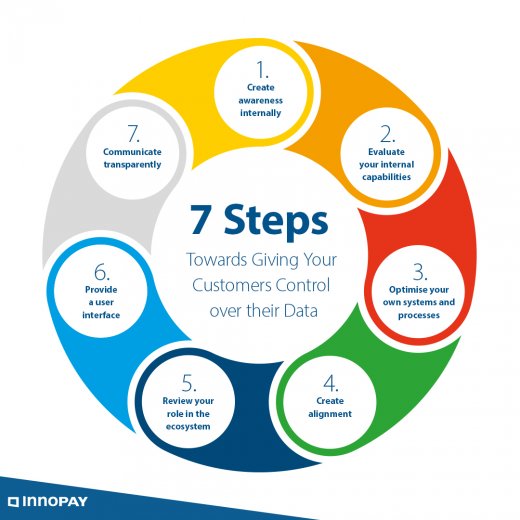7 steps towards giving your customers control over their data
Every minute, on a global level, people send 156 million emails, conduct over 3.5 million searches in Google, and order over US$250,000 worth of goods from Amazon. These are staggering numbers, and the exchange of data is set to continue to grow exponentially.
Smart organisations realise the potential of this data and are continually looking for ways to create value. At the same time, consumers are becoming increasingly aware of their central role in all this; after all, it’s their data, isn’t it? So shouldn’t the ‘data benefit balance’ tip in their direction?
There are several reasons why ‘data sovereignty’ – control over data – should be the central design principle of not only the data economy as a whole, but also of every organisation’s own data architecture. Giving people control over their data and offering fair value in return is an effective way for organisations to improve their customer relationships. Consumers are more willing to share data with organisations they trust, and more trust means a lower transaction cost for data sharing. This results in better access to the data needed to build and grow a business and opens up new opportunities for creating value for customers.
So in order for both businesses and consumers to truly thrive on all the benefits of data sharing, organisations should start tackling the data sovereignty challenge today. But how? Here are seven ways to give your customers control over their data:

1. Create awareness internally
In most organisations there is little awareness about data sharing – neither in terms of the importance of data sovereignty for customers, nor the possible business potential. Communicate your vision and strategy clearly internally, and ensure everyone embraces it. The sovereignty of customers’ data should be kept in mind in all processes. Truly tipping the data benefit balance in the customer’s direction also means exploring the potential of using data to create new products and services that benefit customers. Remember: customers are willing to pay for added value.
2. Evaluate your internal capabilities
Does your workforce have the right knowledge and experience of data sharing? Do you need to create and fill new roles (partner network managers, data managers and so on)? What is the best way to secure the right talent (by recruiting to your own payroll or by working with a flexible workforce for maximum agility)? Which profiles will you need in the next five to ten years?
3. Optimise your own systems and processes
Re-assess your own systems and processes. Can you separate the data from the processes and reuse data internally? And don’t forget to optimise data-heavy processes, such as your customer onboarding process; it should be seamless to ensure that they immediately recognise your digitally responsible attitude towards using their data. Needless to say, it is essential to constantly protect your systems and database against intrusion and data leaks, and for your customers to have the peace of mind that their data is safe in your hands.
4. Create alignment
You are part of a data-sharing chain – not only receiving data from your customers, but also providing data to your suppliers and other business partners. Ensure that they offer you the same transparency that you provide to your customers. Ideally, you should take a proactive approach to creating alignment throughout the chain. Use the INNOPAY 9 building blocks model to align legal, technical, business and governance considerations.
5. Review your role in the ecosystem
Analyse not only your need-to-have data but also the ‘nice-to-have’ data – the data that will help you to create more value for your customers so that they feel more rewarded for sharing their data with you (and hence will ultimately share even more). Can you obtain that from partners in your current ecosystem, or do you need to expand your ecosystem by adding new partners? And what does this mean for your role in this ecosystem?
6. Provide a user interface
Offer your customers a user interface or control panel to allow them to manage which data they are willing to share with you and when. This will establish the necessary foundation of trust for data sharing and – perhaps surprisingly – tends to lead to your customers providing more data rather than less.
7. Communicate transparently
Big data comes with a big responsibility to be transparent about the information you gather. This might sound obvious, but most organisations are not really transparent about what data they collect and why. Be open with your customers about the data you require from them. Demonstrating that they receive a fair value in return will earn you their lasting trust and will ultimately encourage them to share even more data with you.
These seven steps will help you to consider many key aspects of the data-sharing process to continuously strengthen your relationships with customers. As they discover the rewards of sharing data with trusted partners such as yourself, they will become increasingly willing to share more information… which you can then leverage to truly thrive as we move into the digital transactions era.
At INNOPAY, we have already helped numerous customers to speed up their business based on the existing standards, regulations and data-sharing schemes. To tap into our experience and benefit from our proven approaches, or if you have any questions or would like more information, feel free to contact us.




